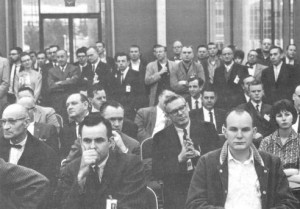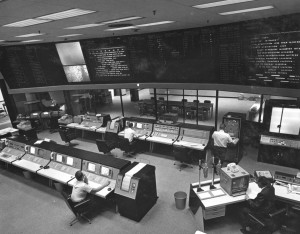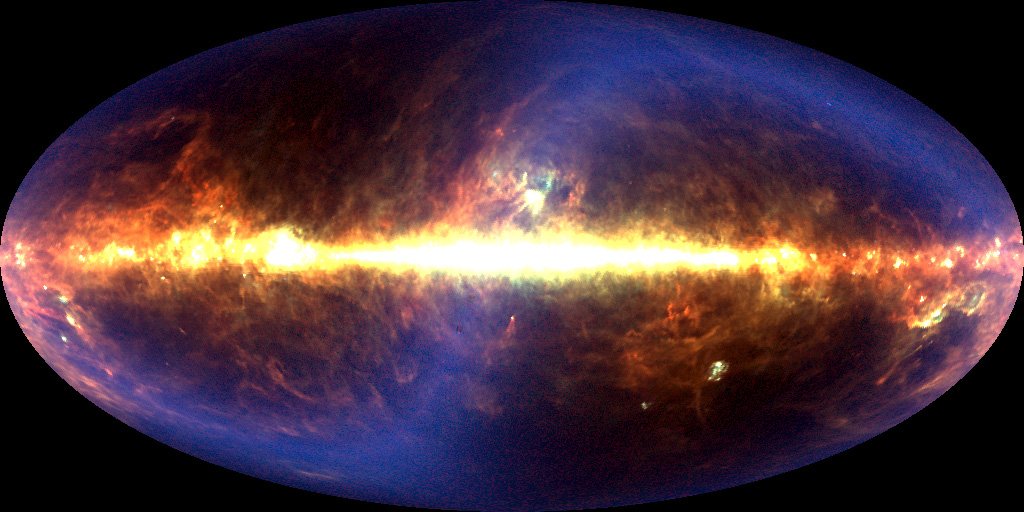
By J.D. Burke
When the world changed with Sputnik on October 4, 1957, we at the Jet Propulsion Laboratory (JPL) were jubilant. Yes, we had been beaten in a race, but we now knew that our fondest hopes would be realized. Soon we and the Wernher von Braun U.S. Army team gained permission to launch Explorer 1, and we were planning missions to the moon.

Technicians prepare the Ranger 4 satellite for use at the Parade of Progress show at the Public Hall in Cleveland, Ohio.
Photo Credit: NASA
On January 2, 1959, the Soviets’ Luna 1, Mechta (Dream), escaped into interplanetary space. To me, this was the real watershed. NASA had been founded in 1958, and JPL, transferred from army sponsorship, had become one of its field centers. We agreed that lunar and planetary exploration should be our central goal. Of course Earth satellites were important, destined, among other things, to found a huge new industry in telecommunication satellites, but these were regarded as not appropriate pursuits for a research laboratory in a university setting. So we decided that JPL should plan to work at the farther frontier and develop Earth satellites only for science missions.
The first American lunar attempts were unsuccessful. Pioneer 4, a tiny, spinning Tin Woodsman’s hat, did follow Luna 1 into interplanetary space, but it and other U.S. lunar missions in 1959 returned no data from the moon. Meanwhile, Luna 2 hit the moon and Luna 3 ended centuries of speculation by imaging its far side. By 1960 we were into serious planning for more ambitious missions to the moon and Venus. Despite its tempting aspect as the first chance in history for humans to send something to Mars, we abandoned that year’s October Mars launch window as unattainable, given our capabilities at the time.
The Soviets did try for Mars. On October 10, 1960, at the instant when Tyuratam was brought by Earth rotation into alignment with a minimum-energy path to Mars, a vehicle lifted off carrying a far greater weight than any ever before lofted by rocket. Intercepted telemetry showed that the loaded upper stages weighed more than thirty tons. A new upper-stage engine started, but its turbine did not reach a stabilized full speed. Four days later, again at the exact right instant for a departure to Mars, another heavy vehicle lifted off. Again the upper-stage engine failed.
These flights, though not announced at the time in either the Soviet Union or the United States, were a powerful stimulus to our efforts. We now knew beyond doubt that we were in competition with determined and well-supported colleagues in the otherwise feared and mistrusted Soviet Union. Today I am privileged to enjoy the friendship of some of them who have survived up to now. Indeed two, Mikhail Marov and Nikolai Tolyarenko, are fellow faculty members of the International Space University.

An audience at NASA’s Jet Propulsion Laboratory listens to a description of the final moments of Ranger 6 in 1964. Ranger 6 impacted the moon as planned on February 2, 1964, but a malfunction disabled its camera system.
Photo Credit: NASA
During that same month, October 1960, I was appointed project manager of Ranger, the first American effort to place scientific instruments on the surface of the moon. Our technical work proceeded in an environment of managerial and political commotion as the army, navy, and air force jockeyed for position in the new space game and NASA struggled to be born.
The Eisenhower administration had a good fundamental policy: the U.S. civil space program would be done in the open, with secrecy only where it was absolutely needed, such as how the Atlas guidance system worked. There were also deeply secret space programs, such as the one openly labeled Discoverer— known in the secret world as Corona and managed by the CIA—to obtain reconnaissance information on Soviet strategic capacities. The military services naturally wanted a piece of the action, and the air force thought it should own the U.S. space program. The navy laid claim by asserting it needed to have important navigation satellites. The army was already launching satellites, and JPL had been connected with the army until NASA was formed. So all three military branches were campaigning against each other in this important national strategic opportunity.
Below this high-level struggle, we had huge arguments about who would be in charge of what—for example who had authority to launch or stop a launch. We also had one part of the science community wanting to obtain scientific information about the earth and its surrounding magnetosphere, creating another controversy. To me, this was a competition with the Soviet Union and getting to the moon for lunar science was the paramount objective; magnetospheric science was secondary. But to the non-lunar scientists, their science was primary. They would say to us, “If my instrument isn’t ready, you should wait until it is.” Our lunar scientists never gave us this problem.
Until things settled down around 1963–64, when the roles and missions became clear and everyone buckled down to do the job, we found a few good people scattered throughout the system who were prepared to work together and ignore the uproar going on around us. U.S. Air Force Major Jack Albert, who by policy might have been an opponent, was a proponent of our team and helped us in many ways. Harold Luskin at Lockheed also collaborated wholeheartedly with us. Having real people, separate from theoretical policies, made things work. Instead of adversaries, they were collaborators.
Despite all the turmoil, we were able to launch five Rangers during 1961 and 1962. All reached orbit and one crashed on the moon, but none returned useful scientific data. As Cargill Hall states in his book,Lunar Impact, “Experience soon drove home the point that project management had to be delegated to a project manager at the pertinent field center, JPL. Experience also made clear the advantages of bringing together agency scientists and engineers both at Headquarters and in the field laboratory.” I was succeeded as project manager by my admired JPL friend Harris M. (Bud) Schurmeier, who took the project through one more failure and on to three triumphant successes in 1964 and 1965.
I remained with Ranger and saw it become the success I had always intended it to be. Hall points out, “The things for which he [Burke] struggled—straightforward, unchanging project objectives; experiments that could not be altered at a scientist’s whim; recognized authority and responsibility in and from all the agencies participating—Burke won all these in defeat. NASA and JPL leaders granted all these to his successor, Schurmeier, who, with new test facilities and procedures, used them skillfully to the advantage of Ranger.”
While we were preparing Ranger 1 in the spring of 1961, President Kennedy announced Apollo, launching the great moon race. Ranger and JPL’s Surveyor lunar soft-landing project came to be regarded as precursors to Apollo, with their original science objectives retained but with a new focus on getting early results. Also, a new project managed by Langley Research Center, Lunar Orbiter, was started to obtain images in support of Apollo.
Meanwhile our Soviet competitors were having a terrible time. At the Venus window in February 1961, they launched two more heavy rockets. One achieved Earth orbit but failed to eject its payload toward Venus. The other, Venera 1, failed on its way to the planet. In 1962 they launched six of their enormous rockets, three to Venus and three to Mars, but only one spacecraft, Mars 1, went on its way and eventually it, too, failed en route. At that opportunity JPL mounted two Venus missions. One launch failed, but the other sent Mariner 2 to Venus, yielding the first data on the planet’s hellish atmosphere.
A long and frustrating period of Soviet lunar attempts followed. Beginning on January 4, 1963, and continuing through the next two years, they launched at least ten missions with only two partial technical successes and no lunar scientific results except the far-side images from Zond 3, a planetary spacecraft sent past the moon. At last, on February 3, 1966, Luna 9 landed and began sending facsimile panoramas from the lunar surface.
Most of the Soviet troubles resulted from failures of management. The kind of management disputes we had early on did not get resolved in their case. For example, their launch vehicles were operated by Soviet armed forces in a military institution that did not have science among its primary objectives. They would launch vehicles before they were ready, and they would fail. They also faced a technical problem that we had to learn about, too, by bitter experience: it’s very difficult to start a rocket engine in microgravity because propellants do not remain where they are needed. Design ingenuity is required to get the liquid into the pumps before an engine can start. One reason the Soviet R-7/ Soyuz rocket was so successful and is still used is that all engines are running on the launchpad before liftoff.

Dedicated in May 1964, the new Space Flight Operations Facility used state-of-the-art equipment for mission operations and communications with JPL’s unmanned spacecraft. One of the first missions to use the facility was Ranger 7.
Photo Credit: NASA
By 1966 we had been collecting telemetry from the Soviet missions for several years. When Luna 9 landed, we were recording the spacecraft’s signals at our station in Eritrea and three other collaborating sites. The Doppler showed retrorocket braking of the descent all the way to the surface. Then the signal went off the air. Another failure? We waited anxiously. Then all of a sudden a new signal appeared: a scratchy, pulsing heartbeat. Wow, it was a fax! We were joyful to see the result of their ingenious system designs and persistent, patient overcoming of successive failures. Soon the American Surveyors, too, began landing on the moon and returning television images and, later, chemical data.
The next Soviet lunar spacecraft was stranded in low- Earth orbit, but then the USSR team achieved another historic milestone by placing the first spacecraft, Luna 10, in lunar orbit. From then on, the Soviet robotic lunar program advanced steadily, with much larger spacecraft launched by the huge Proton rocket, eventually returning small samples of lunar soil and delivering the two Lunokhod rovers to the moon.
On the larger stage of human lunar missions, the preparations for Apollo moved America ahead. We watched with overhead imaging while monstrous facilities for the giant N-1 rocket were built at Tyuratam, and when the four attempted launches of the N-1 failed, we were downcast at the thought that this would bring human lunar exploration to an end—as indeed it did. The greatest N-1 failure wiped out parts of the USSR launch facility on July 4, 1969, just before Apollo 11. When the Soviets decided to cut their losses and give up competition with Apollo, keeping lunar missions going was no longer a priority in either country. Soviet circumlunar human-precursor missions in the late sixties, labeled Zond 4 through 8, had demonstrated ingenious design and execution but did not lead anywhere. By 1976 it was all over.
What should we now conclude about this wonderful and never-to-be-forgotten experience? Both we and our competitors were in too much of a hurry at the beginning, and we had to learn that robotic lunar and planetary exploration is barely achievable even with great effort and care. In spite of their many failures, the Soviets did pull down each of the world’s historic firsts at the moon: the first escape, the first lunar impact, the first far-side images, the first lunar landing, and the first lunar orbit. But when it came to the great contest with Apollo, they could not keep up the pace.
They had funding, they had good people, they had policy support, but they did not have a coherent and stable management system. Apollo succeeded because the whole nation rose to the challenge. With Mercury and Gemini building human confidence and skills in orbit, the robotic craft finding needed information at the moon, the giant Saturn V building upon decades of experience in the von Braun team, and the human lunar spacecraft being created with broad skills in industry, the colossal enterprise was rigorously managed all the way to its end in 1972.









